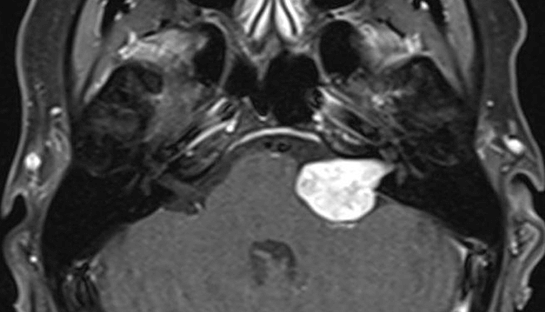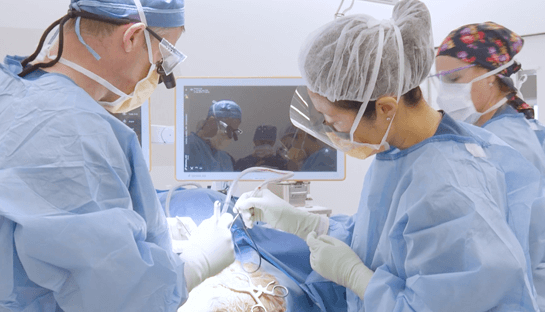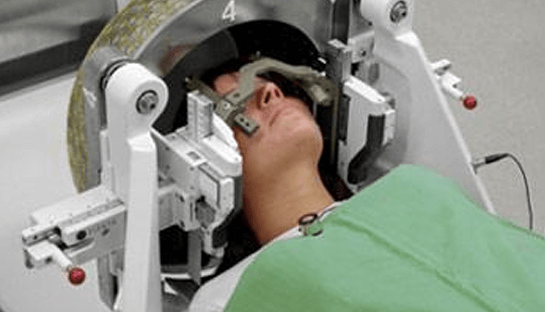What is an Acoustic Neuroma (Vestibular Schwannoma)?
An acoustic neuroma (vestibular schwannoma) is a brain tumour that accounts for a small percentage of all brain tumours. Acoustic neuromas are benign (not cancerous) and usually, but not always, are slow growing. Some may grow and then stop growing altogether.
BANA trustee Professor Simon Lloyd explains what an acoustic neuroma is, what the symptoms are, and the management options.
To watch with subtitles, please click on the ‘CC’ tab on the bottom right of the video.
A Vestibular Schwannoma forms as a benign growth of the Schwann cells which comprise the covering of the nerve sheaths, in this case usually the upper or lower balance nerves. These two nerves comprise two out of the three nerves exiting the hearing and balance organ in the base of the skull passing through a canal to a part of the brainstem where the hearing and balance pathways pass centrally to the cortex of the brain. The third nerve is the cochlear or hearing nerve, and occasionally these tumours can arise from this nerve.
 The fourth nerve passing through the canal is the facial nerve which supplies movements of the face and very rarely a Schwannoma can affect this nerve. This is known as a facial neuroma.
The fourth nerve passing through the canal is the facial nerve which supplies movements of the face and very rarely a Schwannoma can affect this nerve. This is known as a facial neuroma.
It is currently thought that one-sided sporadic acoustic neuromas arise due to a spontaneous mutation (alteration in genetic material) on chromosome 22 2.. This produces an overproduction of the Schwann cells and the formation of a lump, as they multiply producing a small lump or tumour filling the canal housing these nerves.
A tumour expanding in the canal can compress the hearing (cochlear) nerve and produce hearing loss and tinnitus, unsteadiness or imbalance. In many patients these initial symptoms are mild and deceptive, because they are also associated with many other less serious conditions. As a result acoustic neuromas may initially go undiagnosed.
The continued growth of the tumour may touch the fifth cranial nerve (trigeminal) and then facial tingling and subsequent numbness of the facial skin may occur. Continued growth with brainstem compression can produce further symptoms and clearly, if untreated, there is a risk to life if the tumour compresses the brainstem significantly. It is therefore important to diagnose and if necessary treat these tumours from an early stage when the symptoms may only be one-sided tinnitus with a slight high frequently hearing loss.
How is it found?
The diagnosis of this condition is made after the patient reports these symptoms. There is then a careful examination of the ear and the hearing and balance systems, along with a complete neurological examination and then sophisticated audiometry to test the hearing along with a clinical balance assessment. An MRI scan is used to make the final diagnosis and this is the gold standard diagnostic test.
What treatment options do I have?
There are three modern management options for this tumour, depending upon its size, location and the severity of the symptoms.
Incidence
The incidence is approximately 2 per 100,000 per year. That equates to 1200 new diagnoses per year assuming a UK population of 60 million. Based on MRI studies, the true prevalence may be around 0.05% (1 in 200) of the population, which equates to 30,000 people, also assuming a UK population of 60 million.
References
1. Moffat DA, Kasbekar A, Axon PR, Lloyd SK.
Growth characteristics of vestibular schwannomas
Otol Neurotol.2012 Aug;33(6):1053-8.doi: 10.1097/MAO.0b013e3182595454
2. Irving RM, Harada T, Moffat DA, Hardy DG, Whittaker JL, Xuereb JH, Maher ER.
Somatic neurofibromatosis type 2 gene mutations and growth characteristics in vestibular schwannoma
Am J Otol. 1997 Nov; 18(6): 754-60
Stangerup SE, Tos M, Thomsen J, Caye-Thomasen P. True incidence of vestibular schwannoma? Neurosurgery. 2010 Nov;67(5):1335-40
We hope our website helps you to find the information & support that you are seeking. If you have any other questions please feel free to contact us



